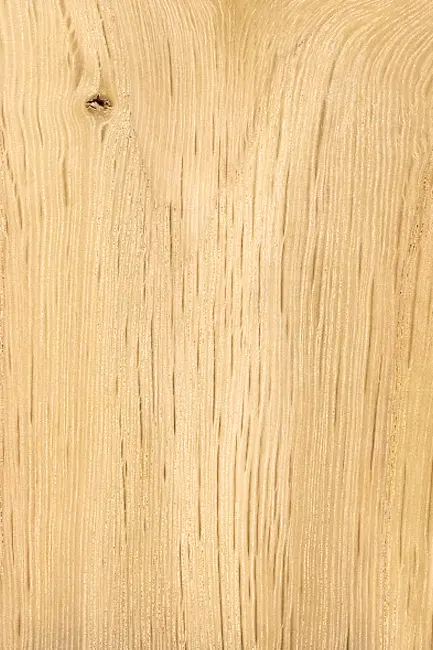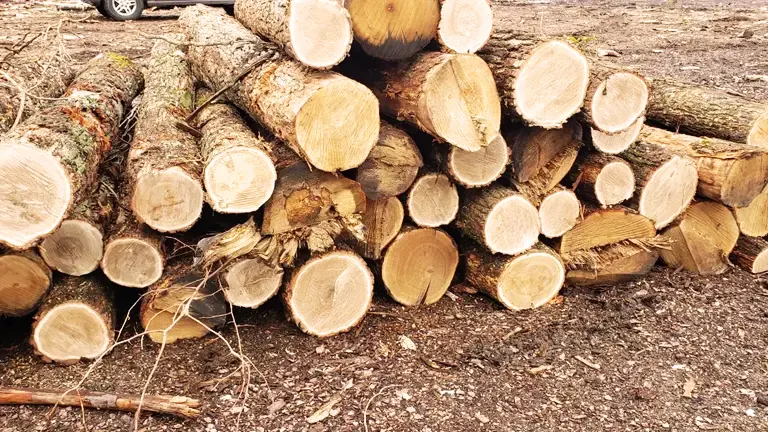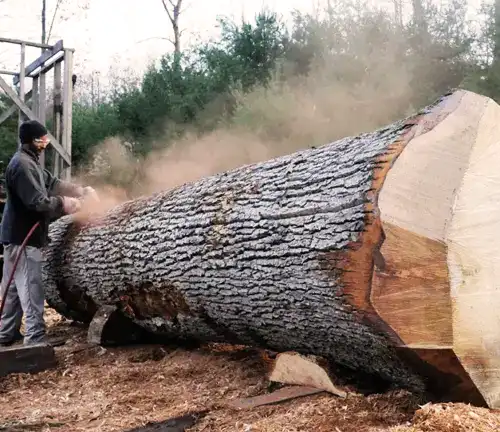Bur Oak Lumber
- June 27, 2023
- 0 comment

Bur Oak, also known as Quercus macrocarpa, is a species of white oak native to North America. This hardwood is noted for its resilience and adaptability, and while it’s not commonly harvested for lumber due to its irregular growth form, it still offers an appealing character and durability when utilized in woodwork.
In terms of appearance, Bur Oak exhibits typical characteristics of the white oak group. The heartwood is light to medium brown, commonly with an olive cast. The sapwood can be very wide and is much lighter in color, usually ranging from a light tan to white. The grain is straight with a medium to coarse texture. The wood often showcases a rugged, natural look that can add a sense of rustic charm to projects.
As for workability, Bur Oak is generally easy to work with, both with hand and machine tools. The grain’s straightness allows it to be cut cleanly, and it responds well to glue and finishes, imparting a pleasing, polished look. One caveat is that it can have large pores, which might necessitate filling for a smoother finish. It possesses good strength and durability, with excellent rot resistance, a characteristic of the white oak group. Typical uses for Bur Oak lumber include furniture, cabinetry, flooring, fence posts, and barrel construction. Overall, while it might not be as commonly used as other oaks, Bur Oak can offer a unique, rustic appeal and dependable durability in a range of woodworking applications.
| Property | Value |
|---|---|
| Common Name(s) | Bur Oak |
| Scientific Name | Quercus macrocarpa |
| Distribution | North America |
| Tree Size | 70-100 ft (21-30 m) |
| Average Dried Weight | 45-52 lbs/ft3 (720-830 kg/m3) |
| Specific Gravity | 0.72-0.83 |
| Janka Hardness | 1,290 lbf (5,740 N) |
| Modulus of Rupture | 15,400 psi (106.2 MPa) |
| Elastic Modulus | 1,900,000 psi (13.1 GPa) |
| Crushing Strength | 7,540 psi (52.0 MPa) |
| Shrinkage | Radial: 5.8%, Tangential: 8.8%, Volumetric: 15.7% |
Color/Appearance
Bur Oak lumber showcases a light to medium brown color, often with golden or honey tones. The wood may exhibit prominent ray flecks, adding to its visual appeal. With time, it can develop a rich patina.

Grain/Texture

Bur Oak typically features a straight grain, though it can be slightly interlocked or irregular. The wood has a coarse texture with large open pores, giving it a distinct look. It finishes well, allowing the natural beauty of the grain to shine through.
Rot Resistance
Bur Oak possesses an excellent natural resistance to decay and rot, making it a highly durable wood. Its heartwood provides exceptional protection against fungal and insect attacks, ensuring a long lifespan.
Workability
Bur Oak is generally easy to work with, both by hand and with machine tools. It cuts cleanly and holds its shape well during machining and turning. However, due to its density, pre-drilling may be necessary for nailing or screwing.

Odor
Bur Oak does not have a distinct or noticeable odor when being worked.
Allergies/Toxicity
There are no known specific allergenic or toxic properties associated with Bur Oak lumber. However, individuals with existing allergies should take necessary precautions and wear appropriate protective equipment when working with any type of wood.
Pricing/Availability
Bur Oak lumber is typically available at a moderate price range. It is commonly found in areas where Bur Oak trees grow, particularly in North America. Local lumberyards and specialized wood suppliers are reliable sources for availability and current pricing.
Sustainability
Bur Oak is usually harvested from sustainably managed forests, ensuring the long-term viability of this hardwood species. Responsible forestry practices contribute to its sustainability.
Common Uses
Bur Oak lumber finds applications in various woodworking projects. It is commonly used for furniture, cabinets, flooring, millwork, paneling, and exterior construction. Its durability, strength, and attractive grain make it a versatile choice for both indoor and outdoor applications.


Frequently Asked Questions (FAQs)
- What sets Bur Oak lumber apart from other oak species in terms of appearance and characteristics?
Bur Oak lumber stands out for its unique appearance, featuring a prominent, wavy grain pattern and large, distinctive medullary rays. Its heartwood varies from light brown to yellowish-brown, while the sapwood is often pale in color. These characteristics make Bur Oak visually distinct from other oak species. - Is Bur Oak lumber suitable for both indoor and outdoor applications due to its durability?
Indeed, Bur Oak is highly durable and naturally resistant to decay and insect infestations, making it suitable for both indoor and outdoor applications. Its robust nature lends itself to a wide range of uses, from interior woodworking to outdoor construction projects. - How does Bur Oak lumber perform in terms of workability and machining, given its unique grain pattern?
While Bur Oak’s wavy grain pattern can present some challenges during machining, it is generally considered workable with the right tools and techniques. Its distinctive grain, although visually striking, may require careful attention to detail when working on intricate designs. - Are there specific regions or climates where Bur Oak lumber is more readily available, or does it grow well across various environments?
Bur Oak is native to North America and is adaptable to a range of climates and soil types. It grows well in various regions, from the eastern United States to the central and southern parts of the country. This wide geographic distribution contributes to its availability. - Are there any unique historical uses or cultural significance associated with Bur Oak lumber?
Bur Oak holds cultural significance among Indigenous peoples and early settlers in North America. Historically, its acorns were a valuable food source, and its wood was used for a variety of purposes, including constructing shelters and making tools. Its long history of use reflects its importance in the cultural heritage of the regions it inhabits.
In the world of hardwoods, Bur Oak lumber emerges as a distinctive and versatile choice, marked by its unique grain patterns and inherent durability. The wavy, eye-catching grain and large medullary rays set it apart visually, while its heartwood, ranging from light brown to yellowish-brown, adds warmth to its appearance. Renowned for its resilience, Bur Oak stands as a reliable option for a variety of applications, seamlessly transitioning from indoor woodworking projects to enduring outdoor constructions. While its machining may require some attention due to its distinctive grain, the challenges are outweighed by the aesthetic rewards. With a rich history intertwined with cultural significance, from providing sustenance to Indigenous peoples through its acorns to serving practical purposes for early settlers, Bur Oak lumber encapsulates a story that echoes through time. Today, it continues to be a valuable resource, appreciated not only for its visual appeal but also for its adaptability and enduring strength.







Leave your comment